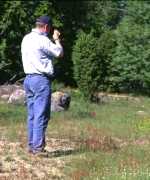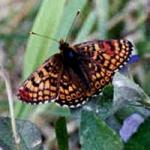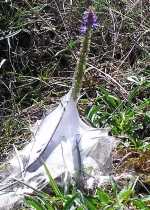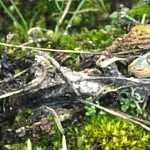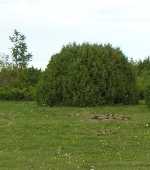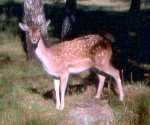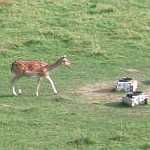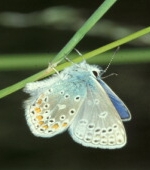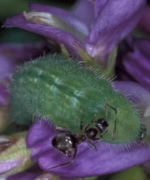Olof Leimar: research
My research is perhaps too diverse to fit under a single convenient label. I often work together with international collaborators, as well as with my PhD students. Some of the issues I have addressed are as follows.
Phenotypic polymorphism and phenotype determination
There are many examples of phenotypic polymorphism in nature, such as males and females in sexual species or the winged and wingless forms in certain insects. An individual's phenotype can be genetically determined (genetic polymorphism), be set by environmental influences during development (phenotypic plasticity or polyphenism), or be randomly determined (bet-hedging). Combinations of these systems are also possible. I am interested in clarifying when the different systems of phenotype determination are likely to evolve. The evolution of local adaptation versus phenotypic plasticity exemplifies this distinction. My former student Sandra Stålhandske investigated this issue for life- cycle traits in butterflies.
I am developing a general theoretical framework that treats the different kinds of phenotype determination in a unified way. In this framework, the characteristics of environmental and genetic cues as predictors of coming selective conditions are unifying features. Environmental cues are such things as temperature, food availability and indicators of population density or the level of predation risk, which are known to be important in adaptive phenotypic plasticity. By genetic cues I mean alleles at one or more polymorphic loci with an influence on phenotype determination. As a consequence of natural selection, allele frequencies can differ between segments of a population, which means that allele frequencies could sometimes function as statistical predictors of coming selective conditions experienced by an individual. The different types of phenotype determination, including genetic polymorphism, can then be regarded as instances of adaptive developmental plasticity. This perspective gives new insights into the evolution of variation in nature.
Behavioural syndromes and animal personalities
Behavioural syndromes or personalities are not only found in humans but in a range of animal species. Individuals differ consistently in their behavioural tendencies and the behaviour in one context is correlated with the behaviour in other contexts. These phenomena are related to the evolution of phenotypic polymorphism and phenotype determination.
Cooperation and mutualism
The evolution of cooperation and the role of reciprocity in cooperative interactions are among the most frequent applications of evolutionary game theory to social behaviour, and I have also made contributions to the field. Part of my work is rather technical, applying the concept of limit ESS to state space strategies for repeated games. I have also studied the evolution of indirect reciprocity and argued for the importance of direct benefits in the evolution of interspecific mutualism.
Interspecific mutualism may well be the most wide-spread form of cooperation between organisms in nature. I have collaborated with my former student Karolina Tegelaar on experimental investigation of the interaction between aphids and ants. Using Aphis fabae and Lasius niger in the lab. Our aim is to measure costs and benefits of the interaction for the aphids, in order to throw light on the conditions for evolutionary stability of the mutualism.
Aposematism and mimicry
I have an interest in the evolution of warning colouration, which I share with several of my colleagues at the Department of Zoology (I have collaborated with Birgitta Tullberg and Gabriella Gamberale Stille on such work). The study of warning colouration, including the evolution of mimetic resemblance in warning colouration, has historically played an important role in evolutionary theorizing. For Müllerian mimicry, some of the basic questions that have been raised are whether organisms involved in mimetic relationships can be cleanly divided into models and mimics (where mimics have evolved to look similar to models but models have not co- evolved with mimics) and whether the evolution towards resemblance was gradual or was characterized by saltational changes in the appearance of the mimics. These questions are the starting points of the project of my former student Alexandra Balogh, and I collaborate with her in analysing theoretical models of the evolution of Müllerian mimicry. My current student Baharan Kazemi approaches these questions using experiments.
Herbivore-plant interactions
Plants have traits that seem to function as defences against herbivory. Apart from structural defences like thorns and spikes, various toxic substances produced by plants may serve to deter herbivores. Mobile generalist herbivores should then react to the levels of defences they encounter while foraging. An interesting issue, with potential relevance both for the the evolution of plant defences and for the spatial distribution of plants in nature, is over which spatial and temporal scales such herbivore food choice operates. I collaborate with my former student Ulrika Alm Bergvall on investigations of food choice in fallow deer, with a conceptual focus on the implications of the foraging behaviour for plant populations with variability in the level of defence.
Insect mobility
Although I find the various theoretical aspects of the evolution of mobility quite fascinating, my research in this field has mainly been empirical and has dealt with butterflies. One important aspect is the method of using large outdoor cages to study butterfly movement behaviour in a manipulated, semi-natural environment. I started this approach in collaboration with my former student Ulf Norberg. There are now several such cages at Tovetorp (the field station of my department) that are used for various kinds of research with butterflies. I collaborated with my former student Karin Enfjäll in experimental investigations of the effect of population density and social interactions on mobility in checkerspot butterflies. One question we were focusing on is whether males pursuing and harassing already mated females can induce the females to leave the local area. I have also collaborated with colleagues at the department (Bengt Karlsson and Christer Wiklund) in using the outdoor cages for the study of butterfly mobility.
Evolution in multidimensional trait spaces
In evolutionary modelling, there has been a tendency to focus on one- dimensional trait spaces. This has, for instance, been the case for the analysis of convergence stability, where one looks for criteria ensuring that gradual evolution in a trait space converges to some point or set of points in the space. There is, however, a qualitative difference between gradual adaptive evolution in one- and in multidimensional trait spaces. In a single dimension, the process of production of mutations can influence the rate of evolutionary change, but it will have little effect on the direction of change. In contrast, in multidimensional trait spaces the possibilities of pleiotropic mutations and genetic correlations imply that the mutational process can also influence the direction of evolutionary change, and this influence will be stronger the higher the dimensionality of the space. My interest is to develop criteria for evolutionary stability that take into account the properties of the mutational process and to apply such criteria, for instance, to the study of the evolution of phenotypic polymorphism and phenotype determination.
Life-history evolution
The adaptive significance of variation in adult body size is one of the most basic issues in the field of life-history evolution. My work in this direction has mostly been empirical, involving butterflies reared in the laboratory, and performed in collaboration with colleagues at my department. One part of this work has dealt with sexual size dimorphism in insects, where Bengt Karlsson, Christer Wiklund and I have argued for the importance of nuptial gift giving for the variability and plasticity in sexual size dimorphism found in butterflies. Another part has dealt with the question of why animals, and in particular butterflies, do not grow to a much larger adult size, since available data and theory seem to indicate that this would increase their fitness. My own guess is that we lack accurate measurements on the effect of size on adult performance under field conditions.
Aggressive behavior
I started out as an ethologist by developing game theory models of fighting behaviour, in collaboration with Magnus Enquist at my department. We also used data from staged contests to test the predictions of our models. In the 1980's, we produced various versions of the so-called sequential assessment game, which has now become a standard component of the theory of aggressive behaviour. More recently, I have collaborated with my former student Henrik Lange in using observations from aviaries on threat signalling and social dominance in wintering birds (great tits) to test some of the influential ideas in this field. One of our conclusions was that dominance interactions between acquainted individuals probably are important in ensuring reliable aggressive communication (honest signalling) in the great tit and that the displays can be interpreted as forming part of a graded signal of motivational state.
Current PhD students
Baharan Kazemi
Predator psychology and the evolution of mimicry
Previous PhD students
Anna Favati
Social dominance and personality in male fowl
Sandra Stålhandske
Plasticity and local adaptation in butterfly life-cycle regulation
Karolina Tegelaar
Evolution of mutualism between aphids and ants
Alexandra Balogh
Evolutionary analysis of Müllerian mimicry
Karin Enfjäll
Mobility and social interactions in butterflies
Ulrika Alm Bergvall
Food choice in mammalian herbivores
Henrik Lange
Social dominance and aggressive signaling in great tits
Ulf Norberg
Mobility and dispersal in butterflies
Annkristin Axén
Mutualistic interactions between butterfly larvae and ants
Thomas Lyrholm
Social organization and genetic structure of sperm whales
Kristjan Lilliendahl
Fattening strategies in wintering passerines
